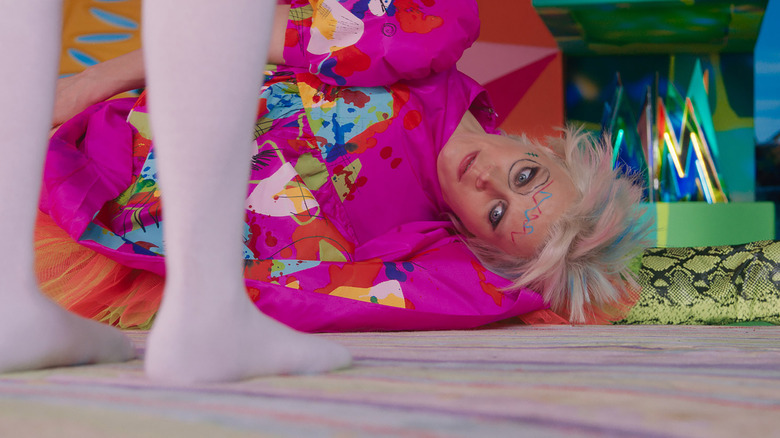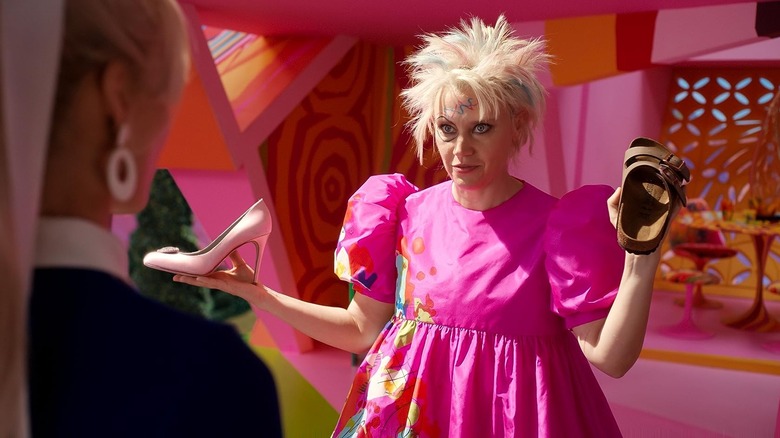Weird Barbie's House Was Inspired By A Classic Horror Movie
This post contains spoilers for "Barbie."
One of the many joys of watching "Barbie" is catching all the film's references to classic cinema. "The Wizard of Oz" was an obvious inspiration for co-writer and director Greta Gerwig's take on the iconic doll, from the yellow pink brick road that cuts through Barbieland to the ghost of Barbie creator and Mattel co-founder Ruth Handler (Rhea Perlman), who gradually emerges as a Wizard-like guide to Stereotypical Barbie (Margot Robbie) on her journey of spiritual discovery. Moreover, the film is a love letter to 20th-century movie musicals in general, as seen in the "I'm Just Ken" sequence — a musical number that includes a Gene Kelly-styled dream ballet where the Kens adapt all-black attire recalling John Travolta's getup from "Grease" — and the bold, vivid color palette of Barbieland, which brings to mind the production design for "The Umbrellas of Cherbourg."
But what about Weird Barbie, aka Stereotypical Barbie's other guide on her path towards enlightenment? Portrayed by Kate McKinnon, the character is a doll who's been played with a little too roughly by their human in the real world, as evidenced by her haphazard hairdo, the multi-colored scribble marks on her face, and her unusually pliable hip flexors. Her flaws and eccentric appearance have also made the character an outcast among the other Barbies, which has led to her leading a solitary life. Weird Barbie's quirky personality is only further extenuated by her knowledge of the real world — itself a concept that Gerwig has said was inspired by the titular character in Lois Lowry's dystopian novel "The Giver."
Meanwhile, Weird Barbie's house draws inspiration from another story about a peculiar, reclusive individual who assists a blonde woman in distress ... one which goes in an extremely different direction after they meet than "Barbie" does.
We all go a little weird sometimes
Speaking to Variety, "Barbie" production designer Sarah Greenwood and set decorator Katie Spencer talked about how they went about designing Barbieland to feel like a life-sized version of real-life Barbie accessories and playsets (all the way down to their "off-kilter" proportions, as Greenwood referred to it). They also touched on Weird Barbie's house, which has a mid-century modern sensibility with its flat roofs, open-concept floor plan, and a larger emphasis on being aesthetically interesting rather than purely functional. Leading up to the house is an oblique set of stairs that Greenwood confirmed was directly modeled after the stairs leading up to Norman Bates' house in the Alfred Hitchcock classic "Psycho." In her words:
"One of my early references is that you go up the stairs, and there's the 'Psycho' house, and we brought in other elements Its design was deliberately skewed with everything pushed out of shape and out of order."
Out of all the homages in "Barbie," this nod to Hitchcock's landmark 1960 horror film is easily one of the best hidden, although it really jumps out once you know to look for it. Of course, unlike "Psycho," Gerwig's film subverts the horror trope of characters who live on the outskirts of society being dangerous, as Weird Barbie ultimately proves instrumental in saving the day and receives an apology from the other Barbies for how they treated her. Still, that didn't stop Greenwood from sneaking in a playfully dark Easter egg that, sadly, doesn't appear in the final film:
"[Weird Barbie's house] has a swimming pool in front, and we painted a shark at the bottom of it."
Does that count as a "Jaws" homage? If so, "Psycho" isn't the only horror classic that inspired Weird Barbie's mojo dojo casa house.
"Barbie" is now in theaters.

